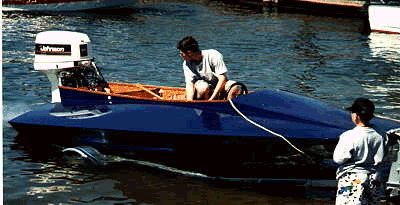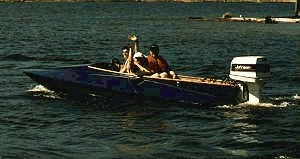Building the Tunnel King - Part 1
by Matthew Green
Continued

Before I get to specific building considerations of the Tunnel King, perhaps a brief overview of high-performance outboard boats is in order. There are basically three kinds of high-speed outboard vessels: the V-bottom, the hydroplane, and the tunnel hull; each has its own variations and inherent advantages and disadvantages.
Vee-bottom speedboats are lightweight modified or deep-V boats with one or more of the following hull features added to increase lift and/or decrease drag: extra lifting strakes, variable deadrise, transverse steps, notched transoms, keel pads, a gull wing bow, et cetera. These boats are easier to build than a tunnel hull, are just as fast, carry weight better, have a more conventional appearance, and have more useful interior room. The problem with small, fast v bottom boats has to do with boat control: although severity varies from model to model and with engine setup, all v-bottoms will chine walk, some violently. They also aren't particularly stable and lean excessively when making tight, high-speed turns.
Hydroplanes are undoubtedly the fastest outboard boats, and in the below-ten-foot size range, are extremely popular building projects. Most hydroplanes are of the "three point" style, in which the boat planes on a cushion of air trapped under the short forward sponsons, and is only in contact with the water at the extreme after ends of these two sponsons and the gearcase/propellor (hence "three points"). Multi-passenger models are very rare due to the extreme weight sensitivity, set-up difficulties, seaworthiness, and safety concerns inherent with these boats. In outright speed, however, hydroplanes are unmatched: and the outboard speed record is currently held by a hydroplane at approximately 176 mph.
Tunnel hulls are somewhat related to catamarans, but have significant differences. The two hulls, called sponsons, are separated by a rectangular-shaped open area, called the tunnel, which is of a constant width the entire length of the boat. The depth of the tunnel is greatest about one-third aft of the bow, and gradually becomes shallower toward the transom. The sponsons are flat, with sharp inner corners, and shallow deadrise, usually between 8-15 degrees. Some tunnel boats have a center sponson flanked by two smaller tunnels, as well as the two outer sponsons. These are called "modified" or "MOD-VP" tunnels, while the conventional two-sponson version is called a "true tunnel". A tunnel hull may have a bow shaped similar to conventional v-bottom boat, may have an exaggerated rounded bow shape, often called a "shovelnose", or may have two sharp points extending out forward from the sponsons, called "pickleforks". The Tunnel King is a shovel-nosed true tunnel, while the Formula One outboard raceboats seen on television are pickle-forked true tunnels (often made of wood !).

When run with a slight bow-up attitude, air is trapped under the bow (as in a hydro), and compressed as it passes down the tunnel, lifting the forward sections of the boa out of the water, reducing drag and therefore increasing speed. When trimmed properly at full speed, only the last 18 inches or so of boat is in the water. Tunnel hulls of the type described are extremely stable at rest and low speeds and are generally easier to control at high speeds than v-bottoms or hydros. Tunnel boats have high speed turning abilities that must be experienced to be believed. They corner flat with no tendency to slide or spin out. Because the tunnel hull has two widely spaced contact points to ride on (plus the gearcase/propellor), chine-walking is virtually eliminated.
Tunnel boats are not for everyone, however. In order to function well, tunnel hulls must be built light and carry light loads. They typically have narrow, shallow cockpits and low freeboards. Although tunnel hulls maintain a soft ride in moderate chop, they are not intended for use in unprotected waters and can be very wet in rough conditions; the Tunnel King is no exception, as it has no windshield.
Although chine-walking is not much of a concern on vessels such as the Tunnel King, two other phenomena are: "blowing over" and "stuffing". Blowing over, or flipping over backwards, occurs when the engine is trimmed out too far, lifting the bow too high in the air. This is especially dangerous when running into the wind, and is exacerbated by improper weight distribution and propellor selection as well. You can imagine what happens when the boat flips over at high speed: the passengers are ejected and likely injured, and the boat is usually damaged, often severely. This problem is not unique to tunnel boats - hydroplanes and fast v-bottoms are prone to it as well. "Stuffing" is rare but far more dangerous. This happens when the boat attempts to go through rather than over a wave. This usually occurs when the boat flies off one wave, becomes airborne, and "stuffs" into the next wave. The boat will be instantly destroyed and the passengers severely injured. Both of these occurrences are preventable and are cause by overly aggressive operators running too fast in rough conditions. For this reason, inexperienced drivers should never operate any fast outboard boat.
Now that I have scared away all potential builders, let me emphasize how much I like my boat. I had some woodworking experience but zero boatbuilding skills when I built my Tunnel King three years ago. It took about eight months to complete, and turned out beautifully; I could easily shorten it to 5 or 6 months next time. I get compliments on it wherever I go, with most people mistaking it for a mid-70's hydroplane raceboat. With only 120 horsepower, I reach speeds of 70+ mph with one person, and low to mid 50's with four people ! In informal "lake challenges", I have only been beaten twice, both times by production fiberglass speedboats packing more than triple my horsepower. I use my Tunnel King for cruising and speeding on large lakes and protected ocean bays and inlets. With the right propellor, the Tunnel King could be used for waterskiing as well.
Are you interested in building your own Tunnel King ? As the Glen-L manual states, the Tunnel King is suitable for amateur construction, although some boatbuilding experience would be a major asset. I strongly recommend reading Dick Koepp's article in Webletter 7, "Plywood Boatbuilding for Virgin Builders". I agree with nearly everything he says in that article, and I recommend potential builders consider and plan out every aspect of the project before they start cutting plywood and mixing epoxy.
The Tunnel King is built using conventional sheet plywood construction, with Douglas fir or a mahogany plywood being specified. The frames are a combination of transverse and vertical solid wood members connected by plywood gussets. The longitudinal members (there are no large stringers) can be mahogany or Sitka spruce. Everything is fastened together with glue (preferably epoxy) and bronze or stainless screws, nails, and carriage bolts. The Tunnel King is ideally suited to modern wood-epoxy saturation construction. There is some flexibility in the design for available materials, intended use, and interior arrangements. The plans package from Glen-L includes four pages of blueprints, a short building manual, a materials list/fastening schedule, and full-size patterns for many parts.
In the next article, I will cover material selection, necessary tools, frame kits, set-up, and the beginning construction of the Tunnel King. Start saving for tools and propellers now!
Additional photos
Further Reading: As I said above, I strongly recommend reading Mr. Koepp's article and following his advice. As well, the following publications will be useful to the potential Tunnel King builder:
- "WoodenBoat" magazine - a good source of information on materials and construction techniques
- "Introduction to High Performance Boating" (a booklet) part number 335763, available at any OMC dealer
- "Everything You Need to Know about Propellers" (a booklet) part number 90-86144-92, available at any Mercury dealer